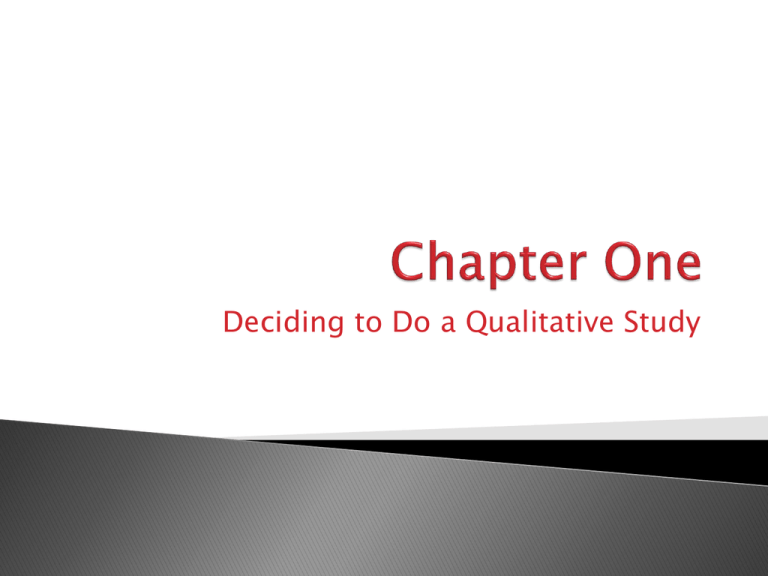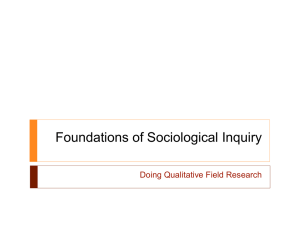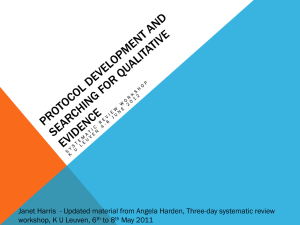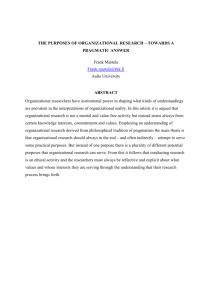Hatch_Chapter1
advertisement

Deciding to Do a Qualitative Study “Any kind of research that produces findings that are not arrived at by means of statistical procedures or other means of quantification” “A research paradigm which emphasizes inductive, interpretive methods applied to the everyday world which is seen as subjective and socially created” “Research procedures which produce descriptive data: people’s own written or spoken words and observable behavior. [It] directs itself at settings and the individuals within those settings holistically; that is, the subject of the study, be it an organization or an individual, is not reduced to an isolated variable or to an hypothesis, but is viewed as part of a whole” • Using qualitative studies in an educational environment relatively recent development • Rich history in anthropology and sociology Ethnographies described “primitive” cultures • • Described in terms of deficiencies in relation to Western culture and norms Late 1800s: Franz Boas one of the first to attempt to understand culture inductively • • Object of study is to describe the knowledge that members use to make sense within their own culture 1900-World War II ◦ Model of the “lone ethnographer” Spending extended periods of time doing participant observations among natives in a distant land Utilized participant observation, interviewing, and artifact gathering Malinowski, Margaret Mead, Radcliffe-Brown ◦ “Chicago sociology” University of Chicago Utilized their city as a social laboratory For three decades produced urban ethnographies that captured human life in the city Slice-of-life approach Used ordinary language of participants (working-class and poor migrants) Capture their point-of-view Criticized as romanticizing the participant and amount of social change Post World War II-mid 1970s Methods became more formalized, scholars became more self-conscious about research approaches ◦ Balance between positivist expectations for validity, reliability, and generalizability and constructivist models of doing research New theories associated with using qualitative research with education, ethnomethodology, phenomenology, critical theory, and feminism began to be recognized 1970s-early 1980s Wide range of paradigms, methods, and strategies Boundaries between the social sciences and humanities were becoming blurred ◦ Interpretive methods such as semiotics and hermeneutics that were developed in the humanities began being adapted for use in qualitative analyses Qualitative work became legitimate form of educational research 1985-1994 (publication of Denzin and Lincoln’s essay) Critical anthropologists challenged norms of classic ethnography ◦ Argued traditional methods and writings product texts that do not and cannot represent lived experience Understandings of experiences processed through language, language is inherently unstable Accused of “creating culture” rather than representing reality Paradigm shift: new ways of thinking about what constitutes “Truth” Development of new perspectives and methods has not meant abandonment of perspectives and methods that came before Deconstructivist and poststructuralist perspectives are being taken seriously ◦ Critical, feminist, and other transformative epistemologies are having a major impact as well ◦ There are still researchers who continue to do work classified as “traditional” or “modernist” 1. 2. 3. 4. 5. 6. 7. 8. 9. 10. Natural Settings Participant Perspectives Researcher as Data Gathering Instrument Extended Firsthand Engagement Centrality of Meaning Wholeness and Complexity Subjectivity Emergent Design Inductive Data Analysis Reflexivity Seek to understand how individuals make sense of their everyday lives When research settings are controlled or manipulated… ◦ They tell us little more than how individuals act in narrowly defined and inherently artificial contexts Individuals act on the world based not on some supposed objective reality… ◦ But on perceptions of the realities that surround them Qualitative data includes: ◦ Field notes from participant observation, ◦ Notes from or transcriptions of interviews with informants, and ◦ Unobtrusive data such as artifacts from the research site or records related to the social phenomena under investigation Data take on no significance until they are processed using the human intelligence of the researcher ◦ Human capacities necessary to participate in social life are the same capacities that enable qualitative researchers to make sense of the actions, intentions, and understandings of those being studied Spend enough time with those participants in those contexts to feel confident that they are capturing what they claim One of the hallmarks of high-quality qualitative work “Blitzkrieg Ethnography” ◦ Spending far too little time in research settings ◦ Serious flaw in qualitative work Describing the meanings individuals use to understand social circumstances rather than trying to identify the “social facts” that comprise a positivist social theory ◦ Max Weber: “interpretive sociology” Stressed the importance of verstehen (understanding) ◦ Blumer: symbolic interactionist theory a) Human beings act toward things on the basis of the meaning that the things have for them b) The meaning of such things is derived from, or arises out of, the social interaction that one has with one’s fellows c) These meanings are handled in, and sometimes modified through an interpretive process used by individuals in dealing with the things they encounter Assumption that social settings are unique, dynamic, and complex ◦ Contexts can be systematically examined as whole, without breaking them down into isolated, incomplete, and disconnected variables ◦ Qual. data are objects, pictures, or detailed descriptions that cannot be reduced to numbers without distorting the essence of the social meaning they represent Including enough detail and actual data to take the reader inside the social situation under examination Required as researchers move from description toward interpretation Instead of pretending to be objective… ◦ Concentrate on reflexivity by applying their own subjectivities in ways that make possible to understand the tacit motives and assumptions of their participants Studies change as they are being implemented ◦ Research questions, methods, and other elements of design are altered as studies unfold Moving from specifics to generalizations Bogdan & Biklen (1992): “You are not putting together a puzzle, whose picture you already know. You are constructing a picture that takes shape as you collect and examine the parts” Qual. researchers do not begin with a null hypothesis to retain or reject To keep track of one’s influence on a setting, to bracket one’s biases, and to monitor one’s emotional responses Goodall (2000): “The process of personally and academically reflecting on lived experiences in ways that reveal deep connections between the writer and his or her subject” 1. 2. 3. 4. 5. Positivist Postpositivist Constructivist Critical/Feminist Poststructuralist Ontological ◦ What is the nature of reality? Epistemological ◦ What can be known, and what is the relationship of the knower to the known? Methodological ◦ How is knowledge gained? Products Ontology ◦ Realists who believe in an objective universe that has order independent of human perceptions Reality driven by universal, natural laws Epistemology ◦ Claim to be objective in search for immutable truth ◦ Researchers and the objects of their study are assumed to be mutually independent Methodology ◦ Careful measurement, manipulation, and control Experiments, quasiexperiments, correlational studies and surveys Products ◦ Knowledge equals accumulated “facts” that have been scientifically verified and generalizations, theories, and laws based on those facts Cause-and effect-dimension Ontology ◦ Reality exists but… Because of the limitations of human inquiry, the inherent order of the universe can never be known completely Epistemology ◦ Researchers see themselves as data collection instruments Use disciplined research techniques to ensure that empirical data, and not their impressions, drive their findings Methodology ◦ Qualitative methods that capture participant perspectives but in rigorously disciplined ways Low inference, systematic procedures dominate data analysis processes, and frequency counts and lowlevel statistics used Products ◦ Analytic generalizations, descriptions, patterns and grounded theory Generalizations are induced from systematic analyses of data that take the form of searches for patterns Deductive processes are used to verify the strength of those patterns Ontology ◦ Universal, absolute realities are unknowable, and the objects of inquiry are individual perspectives or constructions of reality Multiple realities exist that are inherently unique because they are constructed by individuals Epistemology ◦ Individual constructions of reality ◦ Researchers and the participants in their studies are joined together in the process of coconstruction Impossible and undesirable for the researchers to be distant and objective Methodology ◦ Naturalistic qualitative methods Interviewing participants and observing them in their natural settings Products ◦ Case studies or rich narratives that describe the interpretations constructed as part of the research process Readers can place themselves in the shoes of the participants Ontology ◦ The material world is made up of historically situated structures that have a real impact on the life chances of individuals Structures perceived as real Leads to differential treatment of individuals based on race, gender, and social class Epistemology ◦ Knowledge is subjective and inherently political ◦ Guba & Lincoln (1994): “The investigator and investigated object are assumed to be interactively linked, with the values of the investigator inevitably influencing the inquiry” Knowledge mediated through the political beliefs and opinions of the researcher Methodology ◦ Raise consciousness for those being oppressed, leading to social change Methods called “transformative” Require dialogue between researchers and participants ◦ Data collection and emphasis similar to constuctivist research except Critical: improve life chances for individuals at the bottom of the social hierarchy Feminist: making conditions better for women Products ◦ Critiques of the perceived material world Ontology ◦ “Antiparadigm” Deconstruct aforementioned paradigms ◦ Order is created in the minds of individuals in an attempt to give meaning to events that have no “intrinsic or immanent relations” Multiple realities, each with its own claim to coherence, and none can be privileged over another Realities local, subjective, and in flux Epistemology ◦ Deconstructing the notion of universal Truth Grand narratives are constructed in particular social-historical circumstances to serve the purposes of those in power Alternative forms of inquiry such as: queer theory, performance theory, postcolonial theory, critical race theory, and cultural studies Methodology ◦ Focus on understanding data as texts that represent one of many stories that could be told 1. Deconstructivists Use deconstruction as a tool to examine representations of the world, searching for aporia, inconsistencies, or gaps where the internal logic of the text unravels 2. Genealogists Revealing “the ways in which the practice was historically justified, the discourses that were used for justification, and the assumptions underlying forms of representation that are part of the practices” 3. Poststructuralists doing data-based research ◦ Products Analyses that reveal the internal incongruities of discourses and expose the consequences of actions taken based on the assumed Truthfulness of those discourses • • • • • • • • Ethnographies Microethnographies Ethnomethodology Participant Observation Research Interview Studies Focus Group Studies Artifact Analysis Historical Studies and Historiography • • • • • • • • • Grounded Theory Studies Naturalistic Inquiries Symbolic Interactionist Studies Narrative Studies Educational Criticism Phenomenological Studies Case Studies Action Research Projects Collaborative Studies Ethnographies ◦ Describe culture or parts of culture from the point of view of cultural insiders Make sense of everyday experiences ◦ Developed by anthropologists ◦ Involves participant observation, informant interviewing, and artifact collection ◦ Used within postpostivist paradigm Microethnographies ◦ Sociolinguists or others interested in verbal and nonverbal communication Analyses of face-to-face interactions within specific social contexts ◦ Used with postpostivist paradigm Ethnomethodology ◦ Studies the methods that people use to navigate their everyday lives Interested in assessing an individual’s stock of knowledge ◦ Use observation and interview techniques Rigorous discourse analysis procedures to produce generalizations and theories ◦ Used within postpositivist paradigm Participant Observation Studies ◦ Interviewing, artifact collection, and especially direct observation ◦ Not ethnographies because they are much narrower in scope and involve less time in the field Researchers enter with specific interests and/or specific questions ◦ Used within any paradigm Interview Studies ◦ Create special kind of speech event during which they ask open-ended questions, encourage informants to explain their unique perspectives, and listen intently for special language Enter with questions in mind but will generate questions during the interview ◦ Used within any paradigm except positivist Focus Group Studies ◦ Sets of individuals with similar characteristics or having shared experiences who sit down with a moderator to discuss a topic ◦ Used to supplement other qualitative data ◦ Used within any paradigm Artifact Analysis Historical Studies and Historiography ◦ Unusual for artifacts to be primary data source ◦ Advantage: does not influence the social setting being examined ◦ Disadvantage: Interpreting the meaning and significance of objects without social context is difficult ◦ Used within postpositivist paradigm ◦ Involve the collection and analysis of data for the purpose of reconstructing events or combinations of events that happened in the past ◦ Primary sources: oral or written testimony, original documents, photographs, diaries, journals, drawings, mementos, or other original artifacts ◦ Secondary sources: elements created by others that relate to the event (i.e. textbooks, journal articles, etc) ◦ Used within several research paradigms Grounded Theory Studies ◦ Constant comparison Researchers engage in detailed analytic processes that require repeated confirmations of potential explanatory patterns discovered in the data ◦ Used within postpositivist paradigm Naturalistic Inquiries ◦ The goal of capturing naturally occurring activity in natural settings ◦ Used within constuctivist paradigm Symbolic Interactionist Studies ◦ Comprised of “exploration” (i.e., collecting observations, interviews, life histories, letters, diaries, public records, and group discussions) and “inspection” (discriminating analytic elements and isolating relations between elements) ◦ Used within postpostivist paradigm Narrative Studies ◦ Include life histories, life story research, biography, personal experience methods, oral history, and narrative inquiry ◦ Used within constructivist and critical/feminist paradigm Educational Criticism ◦ Observe, interview, and collect artifacts and documents like other qualitative researchers From this, researchers construct stories or portraits of what they experienced and understood in the settings explored Findings look more like the essays of art critics than the “objective” reports found in positivist journals ◦ Used within constructivist paradigm Phenomenological Studies ◦ Combines both interpretive/hermeneutic methods and descriptive/phenomenological methods Phenomenology: how one orients to lived experience Hermeneutics: how one interprets the ‘texts’ of life ◦ Attempt to keep biases and preconceptions in check by exploring own experiences and understandings ◦ Methods: Protocol writing, interviewing, observing, studying experiential descriptions of literature and art and examining diaries, journals, and logs ◦ Used within constructivist paradigm Case Studies ◦ A special kind of qualitative work that investigates a contextualized contemporary (as opposed to historical) phenomenon within specified boundaries Defining the boundaries, or specifying the unit of analysis is the key point in case study design ◦ Used within several paradigms Action Research Projects ◦ Concerned with activity and change Identifying a problem through careful observation, reflecting on the dimensions of the problem, designing a change that addresses the problem, implementing the change, and assessing its effectiveness through careful observation Used within critical/feminist paradigm Collaborative Studies ◦ Work that is distinguished from action research because its principal aims are the generation of knowledge and understanding Research participants as full partners in the research process ◦ Used within constructivist paradigm Research questions central to the inquiry process; but they ought not be the starting point Essential steps to qualitative research 1. Recognize and accept one’s ontological and epistemological beliefs 2. Find a place among the qualitative paradigms 3. Ask research questions 4. Choose a method based on what you want to find out











